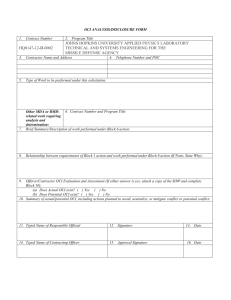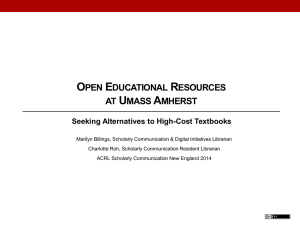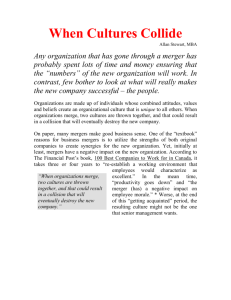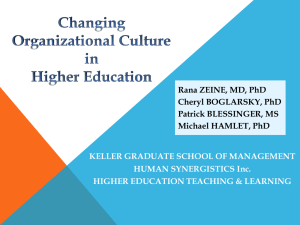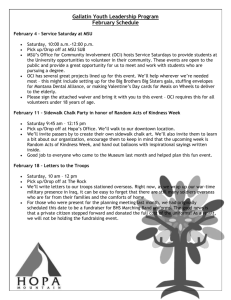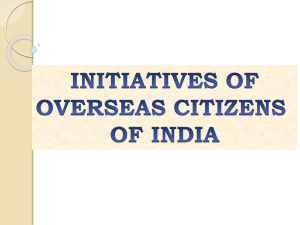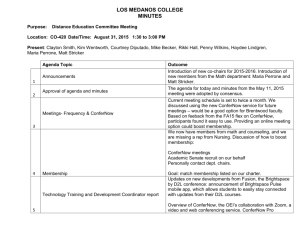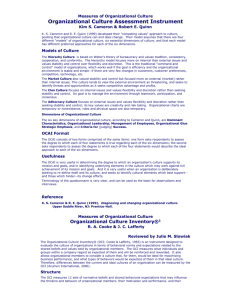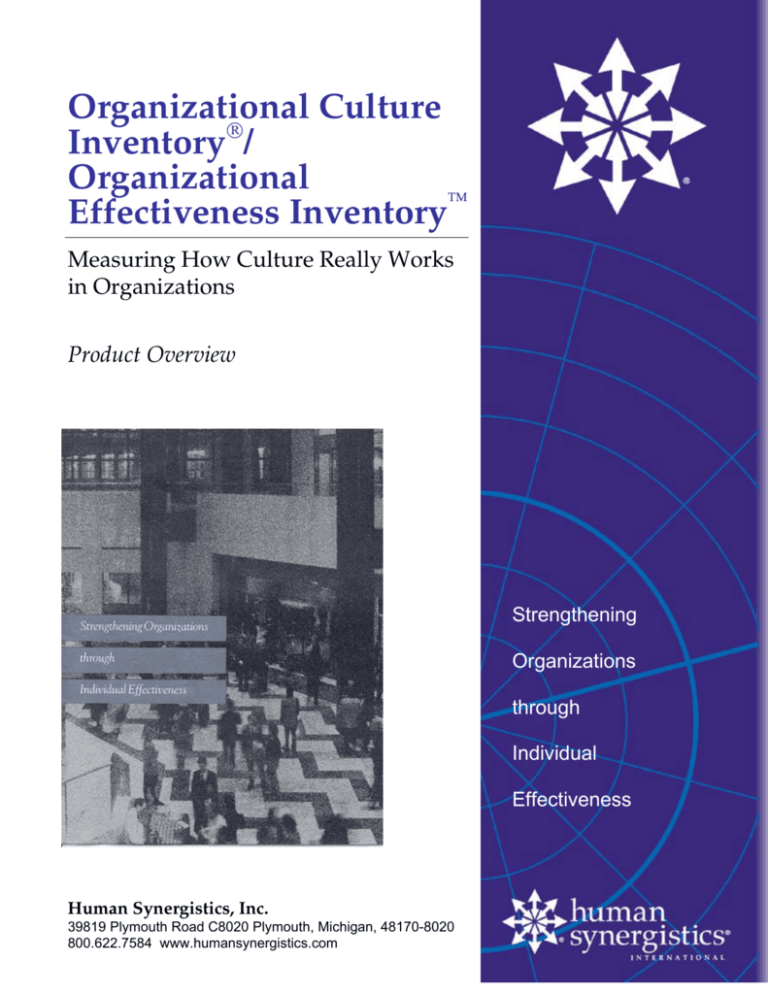
Organizational Culture
Inventory/
Organizational
Effectiveness Inventory
Measuring How Culture Really Works
in Organizations
Product Overview
Strengthening
Organizations
through
Individual
Effectiveness
Human Synergistics, Inc.
39819 Plymouth Road C8020 Plymouth, Michigan, 48170-8020
800.622.7584 www.humansynergistics.com
Is Your Organization’s Culture
an Asset or a Liability?
Managing culture is among the most
important—and most difficult—challenges
facing organizational leaders. Stories about
corporate cultures—as well as the people
behind them—frequently appear in business publications and the news. At one
extreme are the managers who create cultures that provide clear competitive
advantages for their organizations. At the other extreme are the managers who,
perhaps inadvertently or unknowingly, promote cultures that drive their companies
out of business. All companies have cultures. The question is whether your
organization’s culture represents an asset or liability.
The Organizational Culture Inventory (OCI) and Organizational Effectiveness
Inventory (OEI) provide reliable and valid information on the culture that should be
driving members’ behaviors, the culture that is currently driving members’
behaviors, the factors that create and reinforce the current culture, and the outcomes
that result from that culture. Based on this information, leaders and other
organizational change agents can:
•
Determine whether the organization’s culture is an asset or a liability.
•
Identify targets for change and improvement.
•
Pinpoint levers for achieving internal alignment between the organization’s
mission, vision, and values, on the one hand, and its actual day-to-day operating
culture, on the other.
•
Quantify the impact of change initiatives and interventions.
The OCI and OEI are also used by educational institutions for student projects and
academic research.
Call 800.622.7584 • Fax 734.459.5557 • E-mail info@humansynergistics.com • Visit www.humansynergistics.com
Tapping the Code for Success—and Survival:
How Culture Really Works
Understanding that culture is important is critical. But knowing how to manage it is
what determines whether your organization’s culture is an asset or a liability.
The values, mission, and philosophies of an organization help to define what its
operating culture should look like. However, such statements do not directly impact
“how things really work around here.” Instead, the norms and expectations that
define the operating culture are directly influenced by those factors that people deal
with on a regular basis—such as the organization’s systems, structures, and
technologies, as well as the skills and qualities of its people, including its leaders.
When these factors are in alignment with the organization’s values, then the
operating culture looks very much like the ideal. When these factors differ from
espoused values, then the operating culture looks different from the ideal.
The OCI measures both values and norms. The OEI measures the internal factors
that influence culture and the outcomes that result from culture. The results are
presented together in a comprehensive feedback report that tells the story of how an
organization’s culture really works. Based on members’ responses, it describes how
the current culture evolved (via causal factors), where disconnects exist between
values (ideal culture) and norms (current operating culture), and the impact of the
current operating culture on outcomes.
“How Culture Works” Model
OCI
OEI
OCI
Ideal Culture
Values
Causal Factors
Levers for Change
Structures
Mission
and
Philosophy
Systems
Technology
Skills/
Qualities
Operating Culture
Norms
OEI
Outcomes
Effectiveness
Criteria
Individual
Outcomes
Group
Outcomes
Organizational
Outcomes
Copyright © 1997 by Robert A. Cooke, Ph.D.
Model Copyright
1997 Robert A. Cooke, Ph.D.,
OCI Circumplex Copyright by Human Synergistics. All Rights Reserved.
Call 800.622.7584 • Fax 734.459.5557 • E-mail info@humansynergistics.com • Visit www.humansynergistics.com
The Causal Factors that Drive Culture
The OEI measures 31 specific factors that are causally related to culture. These
factors are organized into 5 general categories:
•
Mission and Philosophy, in terms of the extent to which they are clearly
articulated and focus on customer service.
•
Structures, in terms of the extent to which they permit (or restrict) influence,
empowerment, and employee involvement.
•
Systems, in terms of the motivational nature and fairness of human resource
management, appraisal and reinforcement, and goal-setting systems.
•
Technology, in terms of the extent to which jobs are characterized by autonomy,
skill variety, significance, task identity, feedback, and interdependence.
•
Skills/Qualities, in terms of communication, leadership, and sources of power.
Each client’s “all respondent” results are compared to our Historical Averages (based
on 1084 organizational units) and Constructive Benchmarks (based on 172
organizational units with predominantly Constructive operating cultures). These
comparisons help identify drivers of the current culture and potential levers for
culture change.
Technology
Agree
5.0
4.5
4.0
3.5
3.0
2.5
2.0
1.5
Disagree 1.0
Autonomy
All Respondents
Variety
Feedback
Historical Average
Task Identity
Significance
Interdependence
Constructive Benchmark
Causal factors that
are below both the
Historical Average
and Constructive
Benchmark are likely
promoting norms for
counterproductive,
Defensive (rather
than Constructive)
behaviors. If a more
productive culture is
desired, these could be
levers for change.
Copyright by Human Synergistics. All Rights Reserved.
Call 800.622.7584 • Fax 734.459.5557 • E-mail info@humansynergistics.com • Visit www.humansynergistics.com
Ideal versus Current Culture
The OCI can be used to assess both an organization’s operating culture in terms of the
behavioral and personal styles that are expected (i.e., behavioral norms) and its ideal
culture in terms of the behaviors and personal styles that should be expected (i.e.,
espoused values). Both current and ideal OCI results are plotted on a normed
circumplex that compares an organization’s scores (or the scores of its units) to those
of over 900 other organizational units (e.g., departments and divisions).
The OCI measures 12 different cultural styles that reflect 3 general types of cultures:
•
Constructive cultures, in which members are encouraged to interact with others
and approach tasks in ways that will help them to meet their higher-order
satisfaction needs (includes Achievement, Self-Actualizing, HumanisticEncouraging, and Affiliative cultures).
•
Passive/Defensive cultures, in which members believe they must interact with
people in defensive ways that will not threaten their own security (includes
Approval, Conventional, Dependent, and Avoidance cultures).
•
Aggressive/Defensive cultures, in which members are expected to approach
tasks in forceful ways to protect their status and security (includes Oppositional,
Power, Competitive, and Perfectionistic cultures).
The 12 styles and 3 general types of culture are described in detail in the feedback
report and the OCI Interpretation & Development Guide.
Ideal Culture
(Self-Actualizing and Achievement)
Current Culture
(Perfectionistic and Dependent)
Whether your organization’s
current culture will look like
its ideal depends on whether
its systems, structures,
technologies, and
skills/qualities are in
alignment with the stated
values, vision, mission,
philosophy, and goals.
Copyright by Human Synergistics. All Rights Reserved.
Call 800.622.7584 • Fax 734.459.5557 • E-mail info@humansynergistics.com • Visit www.humansynergistics.com
Outcomes of Culture
When an organization’s systems, structures, technologies, and skills/qualities are in
alignment with the stated values, vision, mission, philosophy, and goals, its
operating culture tends to closely reflect its ideal culture and desired outcomes are
achieved. However, when these factors are not in alignment, the operating culture
usually looks quite different from the ideal and, as a result, leads to outcomes that
are not desired by the organization.
The OEI measures 12 specific outcomes associated with long-term effectiveness.
These outcomes are organized into three general categories:
•
Individual outcomes, in terms of the extent to which culture promotes positive
(e.g., role clarity, motivation, satisfaction, and intention to stay) versus negative
(e.g., role conflict, stress, and job insecurity) member attitudes and states.
•
Group outcomes, in terms of the extent to which integration and coordination is
effectively achieved both within and between organizational units.
•
Organizational outcomes, in terms of the organization’s product/service quality
and its ability to adapt to changes in its environment.
Group Outcomes
High
5.0
4.5
4.0
3.5
3.0
2.5
2.0
1.5
Low1.0
Intra-Unit Teamwork and Cooperation
All Respondents
Inter-Unit Coordination
Historical Average
Departmental-Level Quality
Constructive Benchmark
Copyright by Human Synergistics. All Rights Reserved.
The standard feedback report
compares an organization’s
results to the Historical
Average and Constructive
Benchmark. In general,
organizations with
predominantly Constructive
operating cultures score better
than the Historical Average
along most, if not all, of the
OEI outcome measures. In
contrast, organizations with
Defensive cultures usually
score relatively poorly along
several of these measures.
Call 800.622.7584 • Fax 734.459.5557 • E-mail info@humansynergistics.com • Visit www.humansynergistics.com
Mapping a Course for Change
Part of the feedback report focuses on how to use the results to plan for
improvement. The gaps between an organization’s OEI scores and the historical
averages as well as the gaps between the current and ideal cultures are highlighted
to identify goals, targets, and levers for culture change.
Gap Barchart of Outcomes
Desirable
Gaps
50.00
The barchart shows that the
majority of outcomes in this
example are below the historical
average. These results indicate a
strong need for change and
improvement.
40.00
30.00
20.00
10.00
Historical
Average
0.00
-10.00
-20.00
-30.00
-40.00
Undesirable
Gaps
-50.00
Inter-Unit Coordination
Motivation
External Adaptability
Organizational-Level
Quality
Intra-Unit Teamwork and
Cooperation
Satisfaction
Departmental-Level
Quality
Stress
Role Clarity
Role Conflict
Intention to Stay
Job Insecurity
Gaps Between Current and
Ideal Cultures
Copyright by Human Synergistics. All Rights Reserved.
100.00
Desirable
Gaps
80.00
In this example, all of the gaps between the
current and ideal culture profiles are in an
undesirable direction. Thus, targets for change
could focus on the most undesirable gaps or on
the styles most strongly related to the outcomes
goals for change.
60.00
Percentile Gaps
40.00
20.00
0.00
-20.00
-40.00
-60.00
-80.00
Undesirable
Gaps
Avoidance
Affiliative
Self-Actualizing
Humanistic
Conventional
Perfectionistic
Power
Competitive
Dependent
Achievement
50
Approval
Desirable
Gap
Oppositional
Gap Barchart of Causal Factors (Levers for Change)
-100.00
Copyright by Human Synergistics. All Rights Reserved.
40
30
20
Causal factor results that are below the
historical average are inconsistent with
the organization’s Constructive ideal
culture profile and therefore represent
potential levers for change.
10
Historical
Average
0
-10
-20
-30
-40
Communication for Learning
Significance
Articulation of Mission
Customer Service Focus
Empowerment
Distribution of Influence
Interaction Facilitation
Feedback
Upward Communication
Selection/Placement
Employee Involvement
Training & Development
Task Facilitation
Use of Rewards
Autonomy
Organizational Bases of Power
Downward Communication
Goal Emphasis
Interdependence
Consideration
Task Identity
Variety
Respect for Members
Clear and Specific Goals
Total Influence
Personal Bases of Power
Fairness of Appraisals
Jointly Set Goals
Fairly Challenging Goals
Use of Punishment
Fully Accepted Goals
Undesirable -50
Gap
Copyright by Human Synergistics. All Rights Reserved.
Call 800.622.7584 • Fax 734.459.5557 • E-mail info@humansynergistics.com • Visit www.humansynergistics.com
Putting It All Together
The OCI/OEI Feedback Report includes an Executive Summary that highlights key
findings. The summary also includes a visual synopsis of the organization’s OCI and
OEI results, which can be used to quickly identify the causes and effects of any
culture gaps and disconnects.
Summary of OCI/OEI Results
Ideal Culture
(Section 2)
Operating Culture
(Section 4)
Causal Factors (Levers for Change)
(Section 3)
Outcomes
(Section 5)
Structures
TTotal influence
3Distribution of influence
TEmpowerment
TEmployee involvement
Ideal Culture
Individual Outcomes
Current Operating Culture
Systems
Humanistic and Achievement
Mission and Philosophy
TArticulation of mission
3Customer service focus
Human
Resource Management:
TSelection and
placement
TTraining and
development
TRespect for members
Oppositional and Power
Goal Setting:
3Clarity
3Challenge
3Participative
TAcceptance
Positive:
TRole clarity
3 Motivation
3 Satisfaction
3 Intention to
stay
Negative:
TRole conflict
3 Job insecurity
3 Stress
Group Outcomes
Appraisal and Reinforcement:
3Fairness
3Use of rewards
3Use of punishment
TIntra-unit teamwork and
cooperation
TInter-unit coordination
TDepartment-level quality
Technology
TTask identity
3Significance
TInterdependence
3Autonomy
3Variety
TFeedback
Organizational Outcomes
TOrganizational-level quality
TExternal adaptability
Skills/Qualities
Communication:
TUpward
TDownward
TLearning
Bases of Power:
TOrganizational
3 Personal
Leadership:
3Interaction facilitation
TTask facilitation
3 Goal emphasis
TConsideration
Largest Culture Gaps: Avoidance and Self-Actualizing. Gaps between the ideal and current operating cultures are likely due to misalignment
of causal factors (mission and philosophy, structures, systems, technology, skills/qualities) with the ideal culture.
Key:
3Results are at or better than the Historical Average.
TResults are not as good as the Historical Average.
Model Copyright 1997 Robert A. Cooke, Ph.D.,
OCI Circumplex Copyright by Human Synergistics. All Rights Reserved.
Copyright © 1997 by Robert A. Cooke, Ph.D.
Call 800.622.7584 • Fax 734.459.5557 • E-mail info@humansynergistics.com • Visit www.humansynergistics.com
Options for Customizing the OCI/OEI
Add Up to 40 Unique Questions!
The computer-scored OCI has space available for up to 40 supplementary questions
designed by the client organization. This feature enables clients to collect
information on initiatives and processes specific to the organization. Means and
standard deviations for these items are then reported at the “all respondent” level.
Subgroup Analyses
Upon request, OCI/OEI results can be broken down by subgroups for which there
are at least 5 respondents. The subgroup results enable an organization to determine
the pervasiveness of the organizational findings, identify subgroups in which
culture change interventions might first be initiated, and coordinate improvements
between the organizational and subgroup levels.
Mission and Philosophy (Subgroups)
Agree
5.0
Causal factor and outcome
results for each subgroup are
presented in barcharts and
tables.
4.5
4.0
3.5
3.0
2.5
Culture Results (Percentile Scores)
2.0
1.5
Disagree
1.0
Articulation of Mission
Constructive Styles
Customer-Service Focus
Grp.
1
40%
Grp.
2
33%
Grp.
3
41%
Grp.
4
57%
Grp.
5
75%
83%
43%
37%
51%
71%
51%
83%
50%
51%
48%
83%
65%
85%
42%
43%
45%
71%
61%
All Respondents
Current
Ideal
Grp.
1
Grp.
2
Grp.
3
Grp.
4
Grp.
5
All Respondents
Current
Ideal
44%
89%
Management
Production
Accounting
Sales
Humanistic
Human Resources
All Respondents
Historical Average
Constructive Benchmark
Affiliative
45%
Achievement
52%
Self-Actualizing
45%
Copyright by Human Synergistics. All Rights Reserved.
Culture results for each subgroup
are presented in tables as well as
on the circumplex.
Passive/Defensive
Styles
Approval
62%
28%
71%
51%
77%
44%
26%
Conventional
62%
25%
69%
76%
76%
63%
17%
Dependent
52%
23%
58%
75%
73%
42%
16%
Avoidance
60%
28%
68%
60%
67%
24%
23%
All Respondents
Current
Ideal
Aggressive/Defensive
Styles
Grp.
1
Grp.
2
Grp.
3
Grp.
4
Grp.
5
Oppositional
54%
49%
57%
44%
79%
41%
32%
Power
56%
28%
60%
64%
61%
62%
23%
Competitive
56%
38%
59%
64%
60%
51%
28%
Perfectionistic
76%
40%
74%
86%
82%
86%
32%
Copyright by Human Synergistics. All Rights Reserved.
Call 800.622.7584 • Fax 734.459.5557 • E-mail info@humansynergistics.com • Visit www.humansynergistics.com
Data Collection and Pricing
The OCI and OEI can be administered in a group setting or on an individual basis.
Each survey takes approximately 20 to 30 minutes to complete and can be
administered using paper or the Internet. The surveys can be answered by all
members of the organization or by a representative sample. Alternatively half of the
members (or a sample of members) can complete the OCI and the other half can
complete the OEI. If subgroup breakdowns are desired, OCI and OEI responses from
at least 5 members of each subgroup are necessary to maintain the confidentiality.
The OCI-Ideal is used to identify the culture that is required to maximize the
organization’s long-term effectiveness. This survey takes approximately 20 minutes
to complete and should be answered by the organization’s leadership. Other
members of the organization can also complete this form to provide a well-rounded
view, but the participation of the leadership team is critical.
Participant Materials
OCI and OEI (purchased together)
$14.00 per set
OCI Ideal
$8.50
Note: OCI is available on paper in hand-scored (self-scoring) and computer-scored (scan)
form or can be completed online. OEI is available on paper (computer scored) or can be
completed online. Materials prices are the same for all versions.
Scoring
OCI and OEI (computer-scored or completed online)
OCI (hand-scored) and OEI (computer-scored or online)
OCI Ideal (hand-scored)
OCI Ideal (computer-scored or online)
OCI/OEI Feedback Report
Optional Support Materials
OCI Interpretation & Development Guide
OCI Leader’s Guide
OCI Transparencies (set of 20)/PowerPoint Presentation
Cultural Change Situation Participant Booklet
Cultural Change Situation Leader’s Guide
Organizational Change Challenge Kit
$9.00 per participant
$10.00 per participant
$5.00 per survey
$4.00 per survey
$1,200.00
$15.00
$75.00
$50.00
$10.00
$28.00
$60.00
Call 800.622.7584 • Fax 734.459.5557 • E-mail info@humansynergistics.com • Visit www.humansynergistics.com
Surveys & Simulations by
human synergistics
Human Synergistics/Center for Applied Research offers the best in extensively
researched and widely respected training and development materials. Our surveys
and simulations are used throughout the world by business organizations,
governments, non-for-profit organizations, researchers, and educators for leadership
development, personal development, team building, and organizational change.
Individual Development
Provide the catalyst for change in a variety of areas, including personal thinking and
behavioral styles, management competencies, and leadership effectiveness.
Life Styles Inventory (LSI)
The AMA DISC Survey
Leadership/Impact (L/I)
Management Effectiveness
Profile System (MEPS)
Stress Processing Report
(SPR)
Team Development
Give teams the experiences and feedback they need to improve their ability to achieve results.
The Survival Series
Desert Survival Situation
Desert 2 Survival Situation
Subarctic Survival Situation
Jungle Survival Situation
Cascades Survival Situation
Bushfire Survival Situation
Reef Survival Situation
The Challenge Series
Constructive Negotiations
Critical Thinking
Ethical Decision
Organizational Change
Performance Management
Project Management
Strategic Planning
The Business Series
Project Planning Situation
Meeting Effectiveness Situation
Coach
Customer Complaint Situation
Turnaround
Observer’s Guide
Group Styles Inventory (GSI)
Organizational Development
Take organizations to the heart of performance problems and promote solutions that drive
measurable, sustained change and improvement.
Organizational Culture
Inventory (OCI)
Culture for Diversity
Inventory (CDI)
Organizational Effectiveness
Envisioning a Culture for
Inventory (OEI)
Quality
Corporate Ethics Audit (CEA) Customer Service Styles
Cultural Change Situation
Survey (CSSS)
VISIT OUR WEBSITE AT WWW.HUMANSYNERGISTICS.COM OR CALL US AT
800.622.7584 (U.S. ONLY), OR 734.459.1030 (INTERNATIONAL)

